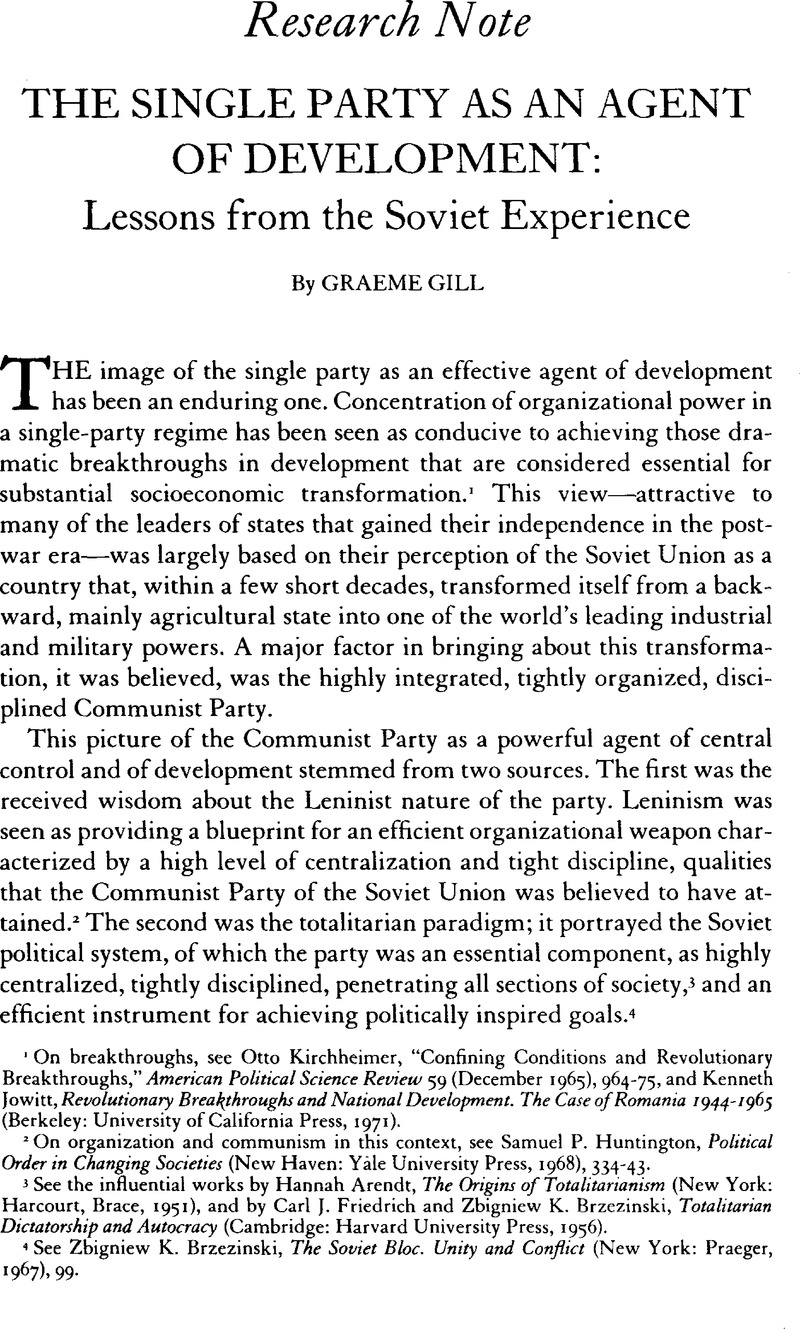Published online by Cambridge University Press: 13 June 2011

1 On breakthroughs, see Kirchheimer, Otto, “Confining Conditions and Revolutionary Breakthroughs,” American Political Science Review 59 (December 1965), 964CrossRefGoogle Scholar–75, and Jowitt, Kenneth, Revolutionary Breakthroughs and National Development. The Case of Romania 1944–1965 (Berkeley: University of California Press, 1971Google Scholar).
2 On organization and communism in this context, see Huntington, Samuel P., Political Order in Changing Societies (New Haven: Yale University Press, 1968), 334Google Scholar–43.
3 See the influential works by Arendt, Hannah, The Origins of Totalitarianism (New York: Harcourt, Brace, 1951Google Scholar), and by Friedrich, Carl J. and Brzezinski, Zbigniew K., Totalitarian Dictatorship and Autocracy (Cambridge: Harvard University Press, 1956Google Scholar).
4 See Brzezinski, Zbigniew K., The Soviet Bloc. Unity and Conflict (New York: Praeger, 1967), 99Google Scholar.
5 Rigby, T. H., Communist Party Membership in the USSR, 1917–1967 (Princeton: Princeton University Press, 1968), 188Google Scholar and 491.
6 XVIIs'ezd vsesoiuznoi kommunisticheskoi partii (b). 26 ianvaria-io fevralia 1934g. Stenograficheskii otchet [XVII congress of the all-union communist party (bolsheviks). 26 January-10 February 1934. Stenographic report] (Moscow, 1934), 557.
7 Örgans such as the control commissions and the security apparatus, both of which had some responsibilities with regard to the work of lower-level party bodies, relied heavily on personal couriers as well. For one discussion, see Niels Erik Rosenfeldt, “Stalinism as a System of Communication,” in John W. Strong, ed., Essays on Stalin and Stalinism (forthcoming).
8 Ibid.
9 The same point applies to the supervisory functions exercised by middle-level party organs over those lower down in the hierarchy. For example, see Partiinoe stroitel'stvo [PS], No. 16(18), August 1930, pp. 18–20Google Scholar.
10 See the discussion in Graeme Gill, “Stalinism and Institutionalization: The Nature of Stalin's Regional Support,” in Strong (fn. 7).
11 Rigby (fn. 5), 52.
12 Deviatyi s'ezd RKP(b). Mart-aprel' 1920 goda. Protokoly [Ninth congress of the RCP(b). March-April 1920. Protokols] (Moscow, 1960), 500.
13 Odinnadtsatyi s'ezd RKP(b). Mart-aprel' 1922 goda. Stenograficheskji otchet [Eleventh congress of the RCP(b). March-April 1922. Stenographic report] (Moscow, 1961), 65.
14 For examples of changes, see Spravochnik partiinogo rabotnika [Handbook of the party worker] (Moscow, 1924 and 1928), Part 4, pp. 144–49, and Part 6, vol. 1, pp. 527–28, 534–46, 553–54.
15 For example, see Trinadtsatyi s'ezd RKP(b). Mai 1924 goda. Stenograficheskii otchet [Thirteenth congress of the RCP(b). May 1924. Stenographic report] (Moscow, 1963), 133–34 and 808; PS (fn.9), No.2(4), February 1930, pp. 3–13; ibid., No. 1, January 1934, pp. 1–7; and XVIII s'ezd kommumsticheskoi partii (b). 10–21 marta 193%. Stenograficheskii otchet [XVIII congress of the communist party (b). March 10–21, 1939. Stenographic report] (Moscow, 1939), 528.
16 Izvestiia tsentral'nogo komiteta VKP(b) [Izv. ts. k.] No. 1(59), January 1924, pp. 64–67; No. 4(62), April 1924, p. 41; No. 1(122), January 18, 1926, p. 4.
17 Ibid., No. 1(122), January 18, 1926, pp. 2–4; No. 6–7(227–28), March 5, 1928, p. 7.
18 Ibid., No. 31–32(152–53), August 9,1926, p. 8; and No. 45–46(166–67), November 27,1926, p. 6.
19 See Getty, J. Arch, Origins of the Great Purges. The Soviet Communist Party Reconsidered 1933–1938 (Cambridge, England: Cambridge University Press, 1985CrossRefGoogle Scholar).
20 For example, PS (fn. 9) No. 18, September 1933, pp. 4–5; No. 16, August 1934, pp. 21–24; No. 4, February 1935, pp. 32–36; No. 11. June 1936, pp. 26–28, and XVII's ezd (fn. 6), 286.
21 For example, PS (fn. 9), No. 16, August 1934, p. 23.
22 For example, ibid., No. 3–4(5–6), February 1930, pp. 5–6; No. 7, April 1931, p. 52; No. 7–8, April 1933, p. 5; No. 11, May 1933, p. 6; No. 1, January 1934; pp. 1–7; No. 10, May 1934, p. 1; No. 13, July 1934, pp. 1–2; No. 16, August 1934, pp. 1–3; No. 18, September 1934, p. 3.
23 See “Dizzy with Success,” in J. V. Stalin, Works (Moscow, 1934), 12, 197–205.
24 XVIIs'ezd ... (fn. 6), 133–34; also pp. 285–87, 552, and 670–71.
25 Gill (fn. 10).
26 See the comments in Izv. ts. k. (fn. 16), No. 32, August 6, 1921, p. 8.
27 The instance most celebrated in Western scholarship is that of Smolensk. See Fain-sod, Merle, Smolensk Under Soviet Rule (New York: Vintage Books, 1958), 48Google Scholar–52; also Narkiewicz, Olga A., The Making ofthe Soviet State Apparatus (Manchester, England: Manchester University Press, 1970Google Scholar), chap. 10.
28 For one example, see A. I. Mikoian, V nachale dvatsatykh [In the beginning of the twenties] (Moscow, 1975), chap. 2. Such a development is also referred to at the X, XI and XII Congresses of the party. See, respectively, Desiatyi s'ezd RKP(b). Mart 1921 goda. Stenograficheskii otchet [Tenth congress of the RCP(b). March 1921. Stenographic report] (Moscow, 1963), 45–46; Odinnadtsatyi ... (fn. 13), 371 and 402; and Dvenadtsatyis'ezd RKP(b). 17–25 aprelia 1923 goda. Stenograficheskii otchet [Twelfth congress of the RCP(b). April 17–25, 1923. Stenographic report] (Moscow, 1968), 66.
29 Gill (fn. 10).